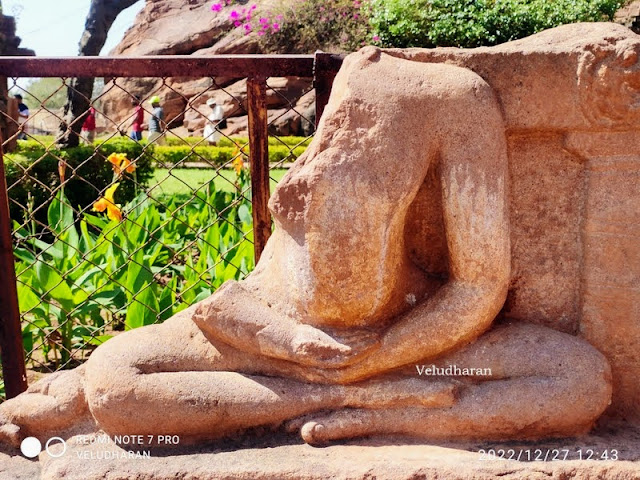The visit to this Hero Stones and Loose sculptures at Badami Museum on the North banks of Agasthya Lake before Mallikarjuna Group of Temples at Badami was a part of “Hampi, Badami, Pattadakal, Mahakuta and Aihole temples Heritage visit” organized by வரலாறு விரும்பிகள் சங்கம் Varalaru Virumbigal Sangam– VVS and எண்திசை வரலாற்று மரபுநடைக்குழு, between 24th December to 28th December 2022. I extend my sincere thanks to the organisers Mrs Radha and Mrs Nithya Senthil Kumar and Mr Senthil Kumar.
Initially it was a place to store and preserve the explored materials, sculptures and inscriptions. Finally it was transformed into a full-fledged museum in 1982. The museum displays a rare collection of local sculptures such as the Lajja Gauri images of fertility cult and prehistoric inscriptions from 6th to 16th century.
The Archaeological Museum was established in the year 1982 houses 181 antiquities including sculptures, decorated architectural members and inscriptions found in and around Badami. There are four galleries in the museum and surrounded by an Open Air gallery. At the entrance, is an open-air gallery presenting Jaina image, Nataraja, Rishabam, kirtimukha, erotic figures and some decorated architectural members.
The four galleries are well furnished, which includes exhibits such as – attractive makara torana-carved on both sides, Siva represented as Kalari, Tripurantaka, Bhairava, Nataraja and Vishnu as Narasimha, Female divinities (Lajja-gauri, matrikās, Bhairavi and others).
The panels depicting Bhāgavata or Krishnalilā scenes are outstanding specimens. The large, scaled model of the prehistoric cave at Shidlaphadi, the trans-slides depicting the various aspects of prehistoric life and the newly organized section exhibit human evolution, prehistoric paintings and stone implements, are important attraction of this museum. The section on conservation, excavation, epigraphy and the newly discovered quarry site along with iron implements, etc. are highly educative and highlight the multifaceted culture of Badami. A rare line drawing of the paintings in cave-III is yet another important exhibit in the museum. Trilingual Audio Video film information is available in the museum.
Apart from this, the museum has departmental publication sales counter and reference library with good number of collection of books regarding art and architecture.
Lajja Gauri
Lajja Gauri (Nude Goddess) is a UNIQUE type of sculpture in the realm of religious sculptural art of the Badami Chalukya period. Suçla representations associated with the worship of Gotheless of fertility and progeny having an ancient folk or indigenous a origin have come to light from many parts of India especially from the Deccan date wise. They range from 3rd - 2nd century BCE. to 17th century CE and include Terracotta figurines stone sculptures and wooden figures. Significantly in the early medieval context a number of such relief sculptures, which were under regular worship, have been discovered within the Chalukya Dominion in the Malaprabha a valley, the cradle of early Chalukyas, this Goddess has appeared in every major site between Aihole and Badami. The one displayed here originally installed in the premises of the Nageswara Temple in the Naganathankolla (Nagaral), is one of the most artistically executed and best preserved images of the goddess.
The Goddess is depicted in high relief, almost is life size on a rectangular stele of Grayish sandstone as laying flat on her back emphasizing the Birth giving posture, in her two upraised hands she gently holds lotus Buds, The most important feature is that in place of the head a fully blown lotus is shown. The torso bears protrusion of fully developed breasts and the knees are drawn apart towards the shoulders for an easy delivery as it were. The goddess wears a lower garment (Ardhoryka) flowing across her thighs and in between the folded legs. She is also decorated with a pair of heavy necklaces, armléls, a pair of bangles and anklets.
The tradition of worshiping this form of mother goddess by women aspiring for off springs is still alive in the vicinity of Badami, Pattadakal and Aihole.
Ref
ASI website : http://www.asidharwadcircle.in/badami-museum/
VISITING HOURS
The visiting hours of the museum are from 9.00 Hrs. To 17.00 Hrs and closed on Fridays.
HOW TO REACH
The Archaeological Survey of India ( ASI ) Museum is about 2 KM from Badami Bus Stand and autos are available from the base of the caves also.
The Bhutanatha Temple is about 22 KM from Pattadakal, 36 KM from Aihole and 453 KM from Bengaluru.
Nearest Railway station is Badami, about 7 KM.
LOCATION OF THE TEMPLE : CLICK HERE
---OM SHIVAYA NAMA ---

















No comments:
Post a Comment